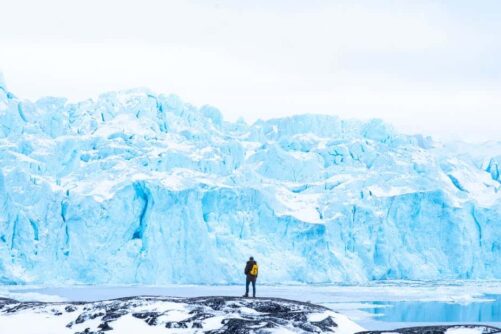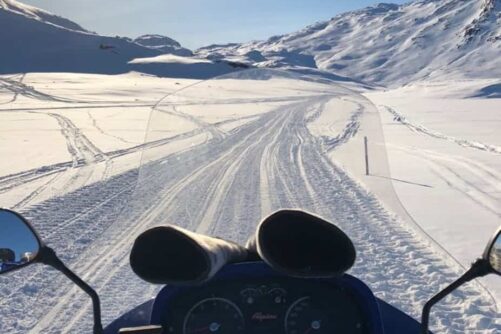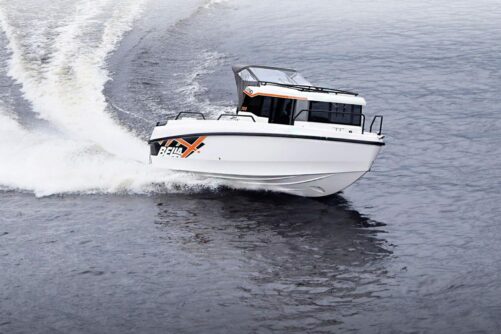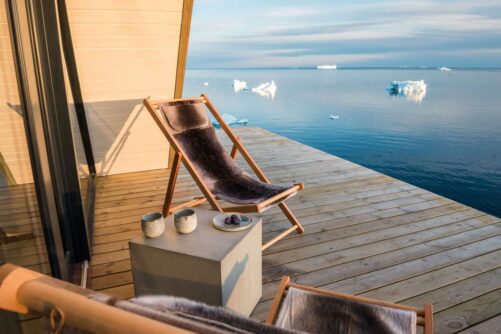

Lichtenau – a settlement in South Greenland
Published: 08/06/2020
Reading time: 6 minutes
In South Greenland, north of Alluitsup Paa, you can travel back in time and experience what used to be a big settlement with up to 500 inhabitants. Today, there are only two left.

We are in the southernmost part of Greenland leaving from Sydprøven or Alluitsup Paa, which is the Greenlandic name. We are going on a day trip to Alluitsoq or Lichtenau, as the settlement is also called. The weather is beautiful and we have an appointment with a local resident from Alluitsup Paa who will come to pick us up.
To get there, we take a remarkably beautiful walk over the fells. It’s a long walk and visibility is clear, so we can see across the entire southern tip from the top of the mountain. It is difficult to find anything resembling a path, but we know we must go up the mountain instead of along the coast. It is too dangerous and this is confirmed on the boat trip back.
We walk through huge areas with crowberries. They are ripe now and we quickly pick handfuls and eat them with relish. It is a walk which an expert can take in under two hours, but we can’t! We must take pains to keep walking in the right direction, because getting lost in this region is no joke.
Our descent to Lichtenau is a little steep, but soft and green, and with the help of the seat of our pants we get down safely. I think there is an easier way down to Lichtenau, but there is no road. All transport here is either on foot or by boat.
In front of us, a small, green oasis of a settlement is revealed. There is a church in the middle and 12-15 houses surround it. This settlement lies like a fine, small, bird’s nest, well protected in a natural cove behind a jutting cliff which provides protection to the northwest against storms and heavy seas. On the other side, it is in the lee of green, fertile fells.

The Herrnhutt mission station in South Greenland
Lichtenau was founded as one of several mission stations in South Greenland by the German brotherhood the Herrnhutt in 1733. They preached the Christian faith and maintained lifelong connections to the population of Greenland.
Typical of the Herrnhutt was their hard work and skilled craftsmanship. They built several of the more important buildings that are still found in Lichtenau. The brotherhood was called to Denmark by King Christian VI to impart its building expertise to Danish craftsmen.
Here in Lichtenau, as they named the place, it is still easy to find examples of fine traditional craftsmanship even though the houses today are in very bad repair. Many have been standing empty for almost a half a century and yet when you walk around, inside or outside, you can still get a feel of the conditions of life and the history of this remote, but incredibly beautiful place.

The last inhabitants of the settlement in South Greenland
Today, only two people still live in this remote settlement. An elderly couple who have lived here all their lives. Kri-stian is 75 years old and his wife Theodora is 64. They live in the white house that is situated high up, with a majestic view across the settlement to the sea. From being a well-functioning village with more than 500 inhabitants, it is now a dead and abandoned settlement.
Hunting used to be good here and was the basis for a well-functioning society. But up through the 1900s living conditions grew harder and depopulation set in. At times there was almost famine in the small, isolated settlement. This is why so many moved to places like Sydprøven in the 1970s and 1980s.

The settlement that was closed down in Greenland
Kristian takes care of it all. He does make-shift repairs where he can and fends off the worst damage from wind and weather. Although nothing is said, there is a strong and poignant sensation that is it he who watches over the last history of the place. Most of the buildings are open, but otherwise, he lends us the keys so we can go inside and look.
In March 1900 the Danish State took over the mission in Lichtenau, and the Herrnhutt said goodbye to the locals and their home in Greenland. As compensation for the takeover, the Brotherhood received DKK 40,000 from the Danish government. In 1900 the brotherhood had a total of 1,637 members living in six missions in Greenland.
Kristian and Theodora have moved up to the white house which is on high ground. They used to live in the light blue house which is next to the church. We are waved on and Kristian arrives carrying a freshly slaughtered lamb over his shoulder. We are invited inside for coffee. They knew we were coming today and we have brought cake.
Two grandchildren are visiting. Happy, lively boys who jump shyly round like fleas. We spend the afternoon walking around the abandoned village with its many stories. It is beautiful, peaceful and picturesque here – the church stands as it did when it was in use. The altar silver is set out and nothing has been removed.

Unusually fertile in Greenland
Here, in this remote place, it is necessary to be as self-sufficient as possible. They have a small, primitive greenhouse where the heat and smell of flowers meet you when you open the door a little. An incredible contrast of beauty and zest for life as opposed to the almost dead and abandoned settlement.
They have impressively green thumbs. There are vegetable and flower gardens, lush and fertile like no other we have seen in South Greenland. Everything is carefully tended and tidy. At the end of the afternoon, the mist draws in across the mountain and the small, abandoned settlement. It gets cold. We are picked up by boat, happy that we don’t have to walk back across the fells.

Back at Alluitsup Paa
Warm coffee and good sandwiches are waiting at the Seaside Whale Hotel. Karen takes good care of us. We see two fin whales right in front of the hotel’s terrace, only 100-150 meters out to sea at most. It’s a wonderful sight. Here on the terrace we sit and fantasize about the possibilities this small settlement would have if the houses were renovated.
Several of the houses, for example, the vicarage, the children’s home, the depot, and the barn for the sheep are all worthy of preservation and they make up the original axis in the settlement together with the beautiful church.
Restoration will not only preserve the values of the buildings and the cultural values, but it will also make the buildings available for holding courses and for tourist purposes in the future. A new epoch could begin for this tiny community – and laughter and noise would again be heard around the houses.
Read more articles from Guide to Greenland
-
4.00(1)Accommodation & tours included!

Highlights of the Arctic winter in 5 days | Ilulissat | Disko Bay
Tour startsIlulissatDuration5 daysFrom 11700 DKKSee more -
5.00(1)Flightseeing with landing!

ISUA Glacier Adventure By Helicopter | Ilulissat | Disko Bay
Tour startsIlulissatDuration1.5 hoursFrom 4695 DKKSee more -

Snowmobile Adventure | Uummannaq | North Greenland
Tour startsUummannaqDuration4 hoursFrom 6000 DKKSee more -
4.50(4)

Whale Safari | Ilulissat | Disko Bay
Tour startsIlulissatDuration3 hoursFrom 1195 DKKSee more -

Boat tour to Qarajaq Glacier | Uummannaq | North Greenland
Tour startsUummannaqDuration8 hoursFrom 4300 DKKSee more -
4.50(2)

Sightseeing In Kangerlussuaq | West Greenland
Tour startsKangerlussuaqDuration2 hoursFrom 480 DKKSee more -
5.00(1)

Ukkusissat Mountain Hike | Nuuk
Tour startsNuukDuration5 hoursFrom 4390 DKKSee more -
5.00(3)Driver included!

Snowmobile tour to UNESCO viewpoint | Ilulissat
Tour startsIlulissatDuration2 hoursFrom 1500 DKKSee more -

Musk Ox, Reindeer & Ice Cap Tour | Kangerlussuaq
Tour startsKangerlussuaqDuration25 minutesFrom 1350 DKKSee more -

Qorlortorsuaq Hike | Qeqertarsuaq | Disko Bay
Tour startsQeqertarsuaqDuration2 hoursFrom 595 DKKSee more -
Flights included

Nature Adventure | South Greenland
Tour startsFrom IcelandDuration8 daysFrom 24200 DKKSee more -
Private charter!

Midnight Sun Cruise | Maniitsoq | West Greenland
Tour startsManiitsoqDuration2 hoursFrom 3700 DKKSee more -
VIP tour for 4 people!

Helicopter and Ice cave tour | East Greenland
Tour startsKulusuk TasiilaqDuration2 hoursFrom 27300 DKKSee more -
5.00(2)All inclusive! Group pricing!

Spend a night in a real Igloo | Ilulissat
Tour startsIlulissatDuration2 daysFrom 4300 DKKSee more -
4.75(8)Extraordinary Dining

Catch’n’Eat | Qooqqut Nuan| Nuuk
Tour startsNuukDuration6 hoursFrom 1595 DKKSee more -
4.90(10)Flexible departures!

The Great Russell Glacier | Kangerlussuaq
Tour startsKangerlussuaqDuration2.5 hoursFrom 2100 DKKSee more -

Luxury Overnight in Iliminaq settlement | West Greenland
Tour startsIlulissatDuration2 daysFrom 3950 DKKSee more -
5.00(8)

Full day adventure on Greenland Ice sheet | Kangerlussuaq | West Greenland
Tour startsKangerlussuaqDuration8 hoursFrom 1095 DKKSee more























